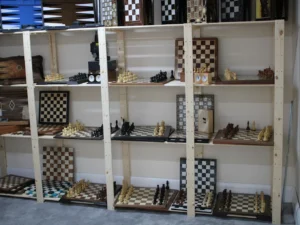
How Does the Pawn Work in a Game Of Chess?

The pawns are the most popular pieces visible on the chess board. Both you and the opponent will have eight pawns each on the front rank. However, it remains the least valuable chess piece and is often the foot soldier in front of a more valuable chess piece.
What will this blog post cover?
- The position of the pawns
- What is the value of the pawn?
- How does the pawn work?
- How does the pawn eliminate?
- The pawn and En Passant rule
- How is the pawn promoted?
- Pawn Terminology
The Position of the Pawn
The value of the pawn is determined by it’s lack of movement and a lack of influence on the game. Losing a pawn or two does not mean you are at a sudden disadvantage, unlike losing a more vital piece such as the queen, where you would be significantly worse off.

What is the Value of the Pawn?
The pawn is the least valuable piece on the chess board, given 1 point for an elimination. The pawn can easily be used as a sacrifice to protect a more valuable piece such as a Knight, Rook or Bishop. The poor mobility of the pawn makes the piece ideal to sacrifice and it can entice your opponent into making a rushed move, leaving one of their more valuable pieces vulnerable.
How Does the Pawn Work?
From its starting position, the pawn can be moved by either one or two squares. However, if the pawn has been moved by two squares, it then resumes to its normal movement of one square at a time.

If the pawn moves by two squares from its initial position, it will resume moving after this in single steps. The pawn can only move by one square beyond this point.

The Pawn can only move forward provided there is no piece in the way, unlike the Knight which can move beyond pieces in the way.
How does the Pawn Eliminate?
The pawn moves forward vertically and can only eliminate an opposition piece diagonally. This can be seen in the diagram below.


The Pawn and En Passant Rule
En Passant, or in other words, ‘In Passing’ is French origin chess terminology that describes the passing of two pawns, side by side. This unique rule only comes into play if you or the opposition pawn has moved 2 squares forward as it’s initial move.


This rule only occurs when the attacking pawn diagonally crosses the opponents pawn, which has moved two squares from its initial position, capturing the adjacent opposition pawn.
In this instance, you assume that although the opposition has made a movement of two squares forward, in accordance to the En Passant move it is as if it has only moved a single square, allowing you to eliminate (almost pulling the piece backwards and eliminating).
Remember, this move can only be applied if the opposition has moved their pawn two squares forward into a position adjacent to your pawn. This rule may not make sense but is incredibly important for an experienced chess player. En passant is utilised to create an opening which will allow for longer range moves using the bishop and rook.
How is the Pawn Promoted?
So far we have discussed the rank of a pawn and the significance of the pawns movement, but pawns do infact possess a hidden weapon. If your pawn reaches the 8th rank or an opposition pawn reaches your first rank, the player is able to promote this chess piece into any piece they desire. This can be a Rook, Knight, Bishop or Queen. As experienced chess players and collectors know, this choice is often the Queen due to it’s vastly superior value, movement and the ability to execute like all other chess pieces aside from the knight (The queen does not move in the ‘L’ shape manner that the knight can perform).


Ofcourse we could have promoted the pawn in D7 to a Queen, however in this instance promoting to the Knight is more advantageous. Equally, there will be opportunities where the Queen on majority of occasions will be better.
Pawn Terminology
Understanding pawn terminology is essential, especially if you are to achieve the status of a grandmaster.
Passed Pawn: A passed pawn is potentially an incredibly dangerous piece, which could lead reaching the 8th rank, allowing this piece to be promoted.
Connected Pawn: A connection of pawns is two pawns lined up diagonally to one another, providing protection to one another and other chessmen in behind.
Backward Pawn: A backward pawn is a pawn that is still a connected pawn, however is unable to advance forward without being eliminated, i.e., an opposition pawn is perhaps blocking this backward pawn from moving further up the board.
Isolated Pawn: A pawn that is either far ahead or perhaps far behind that is in a vulnerable position. This piece has no support from a diagonal pawn and remains weak.
Doubled Pawns: A position on the board occupied by two pawns on the same file, one in front of the other. This commonly occurs when an opposition pawn/piece has been eliminated, resulting in a pawn changing files. This is considered a weak position.





